The AMD Radeon R9 290X Review
by Ryan Smith on October 24, 2013 12:01 AM EST- Posted in
- GPUs
- AMD
- Radeon
- Hawaii
- Radeon 200
XDMA: Improving Crossfire
Over the past year or so a lot of noise has been made over AMD’s Crossfire scaling capabilities, and for good reason. With the evolution of frame capture tools such as FCAT it finally became possible to easily and objectively measure frame delivery patterns. The results of course weren’t pretty for AMD, showcasing that Crossfire may have been generating plenty of frames, but in most cases it was doing a very poor job of delivering them.
AMD for their part doubled down on the situation and began rolling out improvements in a plan that would see Crossfire improved in multiple phases. Phase 1, deployed in August, saw a revised Crossfire frame pacing scheme implemented for single monitor resolutions (2560x1600 and below) which generally resolved AMD’s frame pacing in those scenarios. Phase 2, which is scheduled for next month, will address multi-monitor and high resolution scaling, which faces a different set of problems and requires a different set of fixes than what went into phase 1.
The fact that there’s even a phase 2 brings us to our next topic of discussion, which is a new hardware DMA engine in GCN 1.1 parts called XDMA. Being first utilized on Hawaii, XDMA is the final solution to AMD’s frame pacing woes, and in doing so it is redefining how Crossfire is implemented on 290X and future cards. Specifically, AMD is forgoing the Crossfire Bridge Interconnect (CFBI) entirely and moving all inter-GPU communication over the PCIe bus, with XDMA being the hardware engine that makes this both practical and efficient.
But before we get too far ahead of ourselves, it would be best to put the current Crossfire situation in context before discussing how XDMA deviates from it.

In AMD’s current CFBI implementation, which itself dates back to the X1900 generation, a CFBI link directly connects two GPUs and has 900MB/sec of bandwidth. In this setup the purpose of the CFBI link is to transfer completed frames to the master GPU for display purposes, and to so in a direct GPU-to-GPU manner to complete the job as quickly and efficiently as possible.
For single monitor configurations and today’s common resolutions the CFBI excels at its task. AMD’s software frame pacing algorithms aside, the CFBI has enough bandwidth to pass around complete 2560x1600 frames at over 60Hz, allowing the CFBI to handle the scenarios laid out in AMD’s phase 1 frame pacing fix.
The issue with the CFBI is that while it’s an efficient GPU-to-GPU link, it hasn’t been updated to keep up with the greater bandwidth demands generated by Eyefinity, and more recently 4K monitors. For a 3x1080p setup frames are now just shy of 20MB/each, and for a 4K setup frames are larger still at almost 24MB/each. With frames this large CFBI doesn’t have enough bandwidth to transfer them at high framerates – realistically you’d top out at 30Hz or so for 4K – requiring that AMD go over the PCIe bus for their existing cards.
Going over the PCIe bus is not in and of itself inherently a problem, but pre-GCN 1.1 hardware lacks any specialized hardware to help with the task. Without an efficient way to move frames, and specifically a way to DMA transfer frames directly between the cards without involving CPU time, AMD has to resort to much uglier methods of moving frames between the cards, which are in part responsible for the poor frame pacing we see today on Eyefinity/4K setups.
CFBI Crossfire At 4K: Still Dropping Frames
For GCN 1.1 and Hawaii in particular, AMD has chosen to solve this problem by continuing to use the PCIe bus, but by doing so with hardware dedicated to the task. Dubbed the XDMA engine, the purpose of this hardware is to allow CPU-free DMA based frame transfers between the GPUs, thereby allowing AMD to transfer frames over the PCIe bus without the ugliness and performance costs of doing so on pre-GCN 1.1 cards.
With that in mind, the specific role of the XDMA engine is relatively simple. Located within the display controller block (the final destination for all completed frames) the XDMA engine allows the display controllers within each Hawaii GPU to directly talk to each other and their associated memory ranges, bypassing the CPU and large chunks of the GPU entirely. Within that context the purpose of the XDMA engine is to be a dedicated DMA engine for the display controllers and nothing more. Frame transfers and frame presentations are still directed by the display controllers as before – which in turn are directed by the algorithms loaded up by AMD’s drivers – so the XDMA engine is not strictly speaking a standalone device, nor is it a hardware frame pacing device (which is something of a misnomer anyhow). Meanwhile this setup also allows AMD to implement their existing Crossfire frame pacing algorithms on the new hardware rather than starting from scratch, and of course to continue iterating on those algorithms as time goes on.
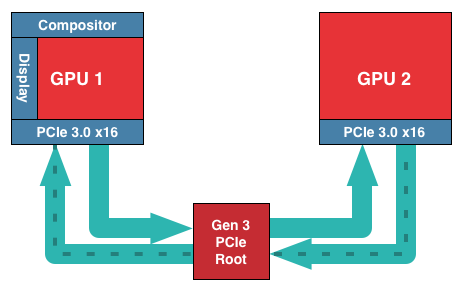
Of course by relying solely on the PCIe bus to transfer frames there are tradeoffs to be made, both for the better and for the worse. The benefits are of course the vast increase in memory bandwidth (PCIe 3.0 x16 has 16GB/sec available versus .9GB/sec for CFBI) not to mention allowing Crossfire to be implemented without those pesky Crossfire bridges. The downside to relying on the PCIe bus is that it’s not a dedicated, point-to-point connection between GPUs, and for that reason there will bandwidth contention, and the latency for using the PCIe bus will be higher than the CFBI. How much worse depends on the configuration; PCIe bridge chips for example can both improve and worsen latency depending on where in the chain the bridges and the GPUs are located, not to mention the generation and width of the PCIe link. But, as AMD tells us, any latency can be overcome by measuring it and thereby planning frame transfers around it to take the impact of latency into account.
Ultimately AMD’s goal with the XDMA engine is to make PCIe based Crossfire just as efficient, performant, and compatible as CFBI based Crossfire, and despite the initial concerns we had over the use of the PCIe bus, based on our test results AMD appears to have delivered on their promises.
The XDMA engine alone can’t eliminate the variation in frame times, but in its first implementation it’s already as good as CFBI in single monitor setups, and being free of the Eyefinity/4K frame pacing issues that still plague CFBI, is nothing short of a massive improvement over CFBI in those scenarios. True to their promises, AMD has delivered a PCie based Crossfire implementation that incurs no performance penalty versus CFBI, and on the whole fully and sufficiently resolves AMD’s outstanding frame pacing issues. The downside of course is that XDMA won’t help the 280X or other pre-GCN 1.1 cards, but at the very least going forward AMD finally has demonstrated that they have frame pacing fully under control.
On a side note, looking at our results it’s interesting to see that despite the general reuse of frame pacing algorithms, the XDMA Crossfire implementation doesn’t exhibit any of the distinct frame time plateaus that the CFBI implementation does. The plateaus were more an interesting artifact than a problem, but it does mean that AMD’s XDMA Crossfire implementation is much more “organic” like NVIDIA’s, rather than strictly enforcing a minimum frame time as appeared to be the case with CFBI.


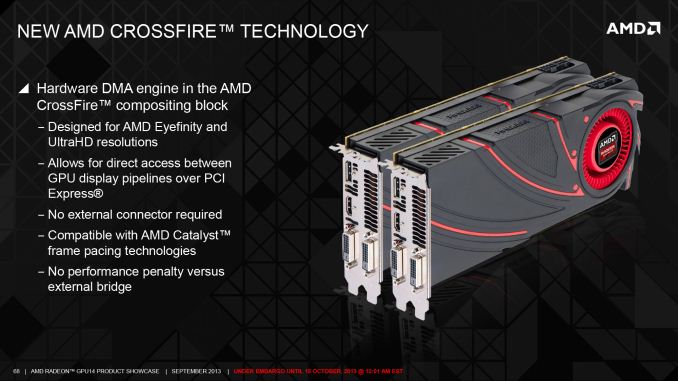
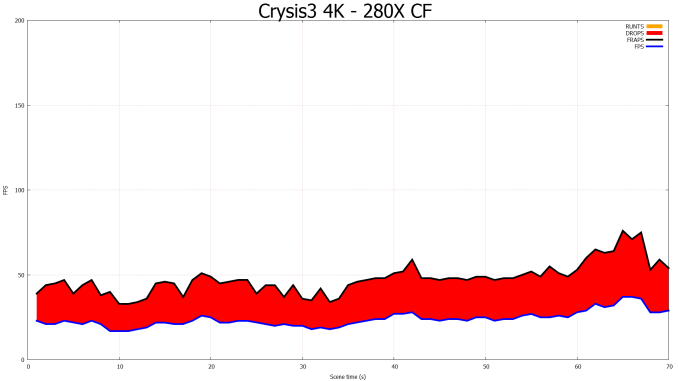
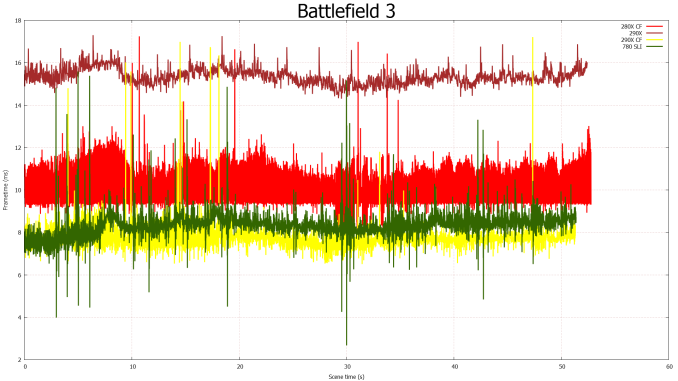
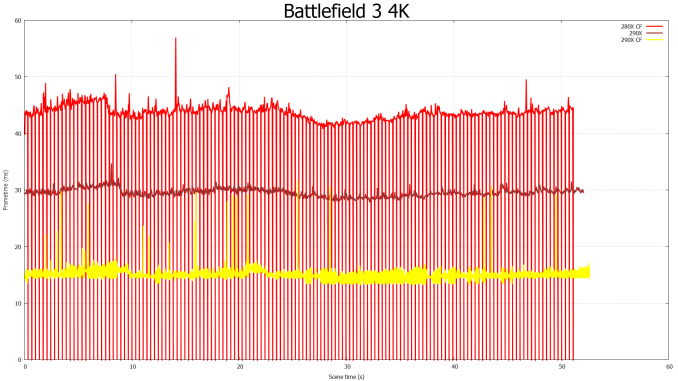








396 Comments
View All Comments
Deaks2 - Thursday, October 24, 2013 - link
Hi Ryan,While I can appreciate the hard work put into the review, just putting up the charts without the explainer pieces is confusing. I had to read HardOCP's review to know what Uber was, your section on Powertune was a work in progress. Also, reading the temperature information was shocking, until, again, I read the relevant section of the HardOCP review and learned that the cards will operate at 95 deg C in order to reduce fan noise.
Also, a comparison to the 7990, the current single-slot performance king, would have been useful, since the R9 290x and 7990 are currently priced similarly. Thankfully, TechSpot included the 7990 and various 7970 and 7950 CF configurations in their review.
As usual, I came to this site first to read the review, but had to go elsewhere to get the context to the charts that you presented.
Thanks!
BryanC - Thursday, October 24, 2013 - link
Actually, I value your commentary more than the charts, which to be honest are similar to the other charts out there. =)anubis44 - Thursday, October 24, 2013 - link
Oh, I'm here for the crafty journalism and the witty banter in the discussion thread :)Seriously, thanks for going the extra mile with the crossfire and FCAT data, Ryan. Much appreciated. Any word on custom cards and the R9 290 (as opposed to the 290X) would also be greatly appreciated. The R9 290 may be my next card.
jeremynsl - Thursday, October 24, 2013 - link
I don't mean to rag on you guys (up late working and all), but it is unprofessional to post unfinished reviews like this. Full stop.I know you have made commitments to hit embargo dates, but is it really worth compromising article quality to this degree? I mean, even if only 10% of readers see it in the unfinished state it's pretty bad. I would not be ok with this, if it was my site and/or my writing.
ZeDestructor - Thursday, October 24, 2013 - link
Like quite a few other people, I would rather read the technical breakdown rather than the benchmark results. If I only cared about benchmark results, I would go around compiling results from several sites to account for configuration differences.It really boils down to preferring a complete review over a performance review. For performance there's the bench tool already, which is far more useful since I can filter out all the irrelevant results
Ryan Smith - Monday, October 28, 2013 - link
Hi guys;Your comments have been heard, so please don't think they're falling on deaf ears.
Frankly we're no more happy about this than the rest of you are, which is why we try to avoid something like this if at all possible. But in this case we can't do a meaningful write-up without the benchmark data, so there's really no getting around it in this case.
The final article ended up being a hair over 22K words. That would normally be a week-long writing job, never mind the benchmarking (new GPU + CF). So I hope if nothing else the belatedly complete article is up to your standards as our readers.
Black Obsidian - Tuesday, October 29, 2013 - link
I would definitely agree that the complete article is up to the standards I've come to expect from Anandtech.But I would also much prefer to wait an extra day or two for the complete article, rather than get the "fill in the blanks" that the 290X review started out as. I come to Anandtech for the in-depth analysis; if that's not available when I click on the article in the first place, I'm less inclined to even bother.
Stuka87 - Thursday, October 24, 2013 - link
Incredible bang for the buck card. $550 is a chunk of money yes, but compared to the competition its a steal!tential - Thursday, October 24, 2013 - link
Jumped to Final Words and it's a work in Progress...That's my favorite part and it's the one I real first!!!!
nooooo.
Elixer - Thursday, October 24, 2013 - link
Looks like nice card...No wonder the green team got their panties in a bind.